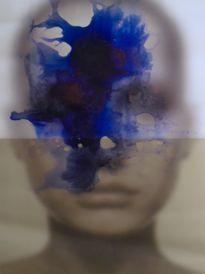Hailing a cab in a hurry to get to my scheduled interview with the Iraqi artist Halim Al-Karim, I thought I’d need to apologise. However when I arrived at the Artspace London Gallery, he was busy with another journalist, offering me some time to look around and survey the exhibition.
Immediately, I was taken aback by what I can only describe as a contemplative yet ambiguous beauty present in his pieces and I understood why so many of his images have been so celebrated and repeatedly showcased at exhibitions all around the world.
They are of a larger scale than I had somehow anticipated, ranging from 220 cm x 130 cm at the largest and 90 cm x 60 cm at the smallest. Whilst many of the pieces are politically provocative, others are based more on female beauty and sexual seduction. In particular, the Goddess Series, the New Orientalism 6 and the Untitled 10, from the King’s Hareem Series.
Al-Karim’s muse is always in a blur, out-of-focus and never identified, though he uses real life models – it is one of his rules to never disclose their identities. Then there is his play with the light and shadows, which gives the pieces different visual interpretations from various angles with unusual optical effect.
Above all, one is compelled to engage with the recurring themes of Al-Karim’s personal life and how they intertwine with those of his home country Iraq, which he had to flee in 1991 in order to survive and physically stay alive.
In emotional and psychological exile since, his art tries to make sense of the awful tragedies that have befallen him and his countrymen. Al-Karim has indeed suffered greatly, having lost four brothers and one sister because of multiple Iraq wars and it is still hard for him to contemplate ever going back.
His style takes on a subtle imaginative form, but always rooted in the enduring horrors of fighting and the influence it has on the psychology of its victims, as well as for the artist himself to get away from the violence through love and the creative process. His work also challenges the hidden or secret nature of certain human behavior.
One of Al-Karim’s techniques is to put a veil of silk or other light fabric on top of the pieces, to indicate the thin line between reality and illusion, as well as to project the distant lands of the artist’s memory, fantasy, dreams as well as terror and nightmares.
He also addresses the potential power of collective memory versus individual awareness, of the close relationship between love and hate, women and politics. His Schizophrenia piece is especially powerful as it represents a split in the psychology of a people and the deceptive nature of governments.
Currently showing at Artspace London Gallery for the first time are three pieces entitled the Eternal Love Series, originally completed in 2010, which the artist expands upon in the Interview transcript.
Another set of images, the Seclusion in Pigalle Series, are of a purely sexual nature and show women in intimate naked contact; but they are a little difficult to locate in the Gallery. Placed right at the back of the lower level, one has to wonder whether they were deliberately hidden at the last minute to not affront some of the more conservative Arab viewers.
Witness from Baghdad 2013 at Artspace London Galley is Al-Karim’s first solo exhibition in London, UK, organized to coincide with the tenth anniversary of the Iraq War. A small percentage of sales will go towards the charity The Young Mesopotamians, which is an educational initiative to foster the next generation of young artists in Iraq. Their Facebook page: Young Mesopotamians.
I do highly recommend a visit before it ends on 23 February 2013. More information:Witness from Baghdad.
Halim Al-Karim: Artist Biography
Halim Al-Karim was born in Najaf, Iraq in 1963 and studied at the Academy of Fine Arts in Baghdad. He had to endure much hardship under Saddam Hussein and at one point, lived in hole for three years to escape military service for war. He has lost a number of family relatives over the years, including four brothers and a sister.
Able to flee in 1991, he sought asylum in the Netherlands, where he studied Photography at the Gerrit Rietueld Academy from 1996 to 2000, which is now his preferred medium of work.
Today, he lives between Denver, Colorado in the Unites States and in Dubai, in the United Arab Emirates. His work has already been exhibited all around the world, including the United State, the Gulf, Middle East and Europe. Most notably, his work was a part of an exhibition at the Saatchi Gallery in London in 2009 and in October 2011, a solo exhibition in New York.
Note: This article was first published circa February 2013


